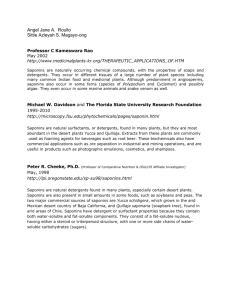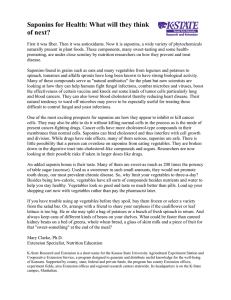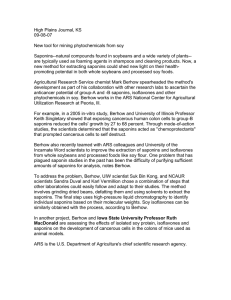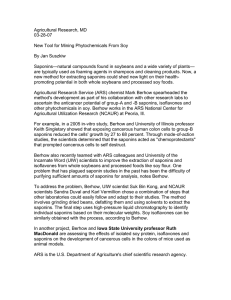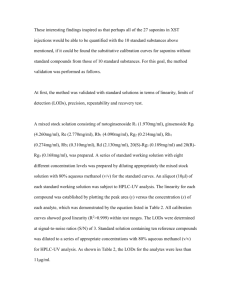Document 14258245
advertisement
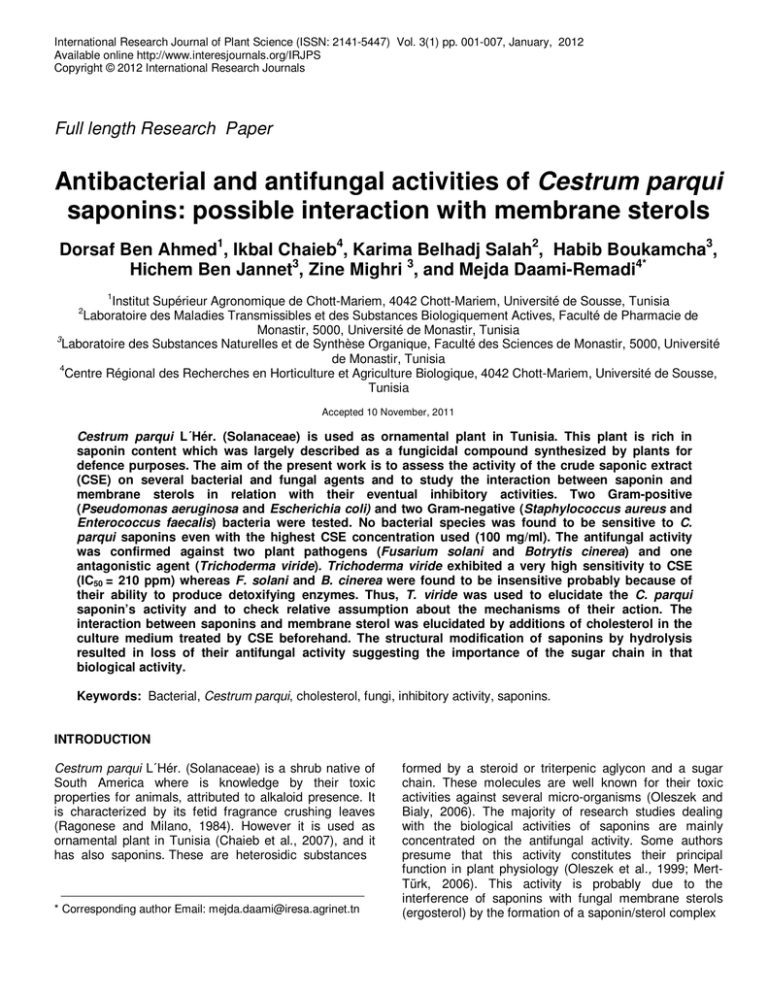
International Research Journal of Plant Science (ISSN: 2141-5447) Vol. 3(1) pp. 001-007, January, 2012 Available online http://www.interesjournals.org/IRJPS Copyright © 2012 International Research Journals Full length Research Paper Antibacterial and antifungal activities of Cestrum parqui saponins: possible interaction with membrane sterols Dorsaf Ben Ahmed1, Ikbal Chaieb4, Karima Belhadj Salah2, Habib Boukamcha3, Hichem Ben Jannet3, Zine Mighri 3, and Mejda Daami-Remadi4* 1 Institut Supérieur Agronomique de Chott-Mariem, 4042 Chott-Mariem, Université de Sousse, Tunisia Laboratoire des Maladies Transmissibles et des Substances Biologiquement Actives, Faculté de Pharmacie de Monastir, 5000, Université de Monastir, Tunisia 3 Laboratoire des Substances Naturelles et de Synthèse Organique, Faculté des Sciences de Monastir, 5000, Université de Monastir, Tunisia 4 Centre Régional des Recherches en Horticulture et Agriculture Biologique, 4042 Chott-Mariem, Université de Sousse, Tunisia 2 Accepted 10 November, 2011 Cestrum parqui L´Hér. (Solanaceae) is used as ornamental plant in Tunisia. This plant is rich in saponin content which was largely described as a fungicidal compound synthesized by plants for defence purposes. The aim of the present work is to assess the activity of the crude saponic extract (CSE) on several bacterial and fungal agents and to study the interaction between saponin and membrane sterols in relation with their eventual inhibitory activities. Two Gram-positive (Pseudomonas aeruginosa and Escherichia coli) and two Gram-negative (Staphylococcus aureus and Enterococcus faecalis) bacteria were tested. No bacterial species was found to be sensitive to C. parqui saponins even with the highest CSE concentration used (100 mg/ml). The antifungal activity was confirmed against two plant pathogens (Fusarium solani and Botrytis cinerea) and one antagonistic agent (Trichoderma viride). Trichoderma viride exhibited a very high sensitivity to CSE (IC50 = 210 ppm) whereas F. solani and B. cinerea were found to be insensitive probably because of their ability to produce detoxifying enzymes. Thus, T. viride was used to elucidate the C. parqui saponin’s activity and to check relative assumption about the mechanisms of their action. The interaction between saponins and membrane sterol was elucidated by additions of cholesterol in the culture medium treated by CSE beforehand. The structural modification of saponins by hydrolysis resulted in loss of their antifungal activity suggesting the importance of the sugar chain in that biological activity. Keywords: Bacterial, Cestrum parqui, cholesterol, fungi, inhibitory activity, saponins. INTRODUCTION Cestrum parqui L´Hér. (Solanaceae) is a shrub native of South America where is knowledge by their toxic properties for animals, attributed to alkaloid presence. It is characterized by its fetid fragrance crushing leaves (Ragonese and Milano, 1984). However it is used as ornamental plant in Tunisia (Chaieb et al., 2007), and it has also saponins. These are heterosidic substances * Corresponding author Email: mejda.daami@iresa.agrinet.tn formed by a steroid or triterpenic aglycon and a sugar chain. These molecules are well known for their toxic activities against several micro-organisms (Oleszek and Bialy, 2006). The majority of research studies dealing with the biological activities of saponins are mainly concentrated on the antifungal activity. Some authors presume that this activity constitutes their principal function in plant physiology (Oleszek et al., 1999; MertTürk, 2006). This activity is probably due to the interference of saponins with fungal membrane sterols (ergosterol) by the formation of a saponin/sterol complex 002 Int. Res. J. Plant Sci. generating pores formation and consequently, loss of cell integrity. Furthermore, these saponins with alcaloidic aglycone can not only bind to sterol but also straightforwardly extract it from the membrane (Morrissey and Osbourn, 1999). The mechanism of action of saponins has been elucidated against Fusarium solani where mutant strains defective out of membrane sterols are able to infect the green fruits of tomato rich in αtomatine (a steroidic saponin) (Morrissey and Osbourn, 1999; Papadopoulou et al., 1999 ). Many research works have showed that the activity of saponins is more related to their sugar chain and thus, any modification of this chain can provoke modification of the biological activity of the entire molecule. Consequently, fungi can resist to plant saponins by the partial or the total degradation of sugar chains thanks to their enzymatic arsenal (Bourab et al., 2002; Barile et al., 2007; Tsuzuki et al. 2007; Stuardo and San Martyn, 2008; Yadava and Chakravarti, 2009). The antifungal activity constitutes an interesting property for the assessment of saponin’s activity and quantity in plants. Moreover, the antifungal tests are relatively precise and simpler than chromatographic and spectroscopic techniques. In fact, some in vitro tests are conducted by using fungal species belonging to Trichoderma genus because they are particularly sensitive to saponins (Jurzysta, 1986). Cells of the prokaryotes such as bacteria do not contain membrane sterols suggesting that these organisms are not sensitive to this type of molecules as reported by several authors (Morrissey and Osbourn, 1999). Sprag et al. (2004) pointed that saponins did not inhibit microbial growth of dense populations. In this work, the antibacterial and antifungal activity of the crude saponic extract (CSE) of a local ecotype of Cestrum parqui was evaluated against several bacterial and fungal agents and the interaction of saponins and membrane sterols was studied in relation with their eventual biological activities. MATERIALS AND METHODS Bacterial agents Four bacterial reference strains were tested: two Grampositive (Pseudomonas aeruginosa and Escherchia coli) and two Gram-negative (Staphylococcus aureus and Enterococcus faecalis). Bacterial strains were gratefully provided by the Faculty of Pharmacy of Monastir, Tunisia. They were cultivated at 37°C in Luria broth (LB) medium at 200 rpm in rotary shaker. For their long term preservation, cultures were maintained at -20°C in LB medium supplemented with 15% glycerol. Fungal agents Fusarium solani was isolated from potato tubers showing typical symptoms of dry rot and Botrytis cinerea was obtained from tomato fruits exhibiting gray mold signs. Trichoderma viride was gratefully provided by the Laboratory of Phytopathology of The Regional Center of Research in Horticulture and Organic Agriculture, Tunisia. All fungal agents were cultured on potato dextrose agar (PDA) medium supplemented with 300 mg/l of streptomycin sulphate and incubated for one week at 23°C before use. For their preservation, up to 12 months, monoconidial cultures were maintained at -20°C in a 20% glycerol solution. Extraction of saponins Saponin extraction was performed according to Chaieb et al. (2007). The leaves of C. parqui were obtained from the garden of the National Tunisian Agronomic Institute, Tunisia. They were dried in a steamroom at 40°C for 4 days and the dried leaves were finely grounded. One hundred grams (100 g) of the obtained leaf powder was washed with petrol ether and extracted three times with 300 ml of methanol. After filtration, the methanol was evaporated by means of a rotary evaporator at 40°C. One gram (1 g) of the total obtained dry residual weighing (6 g) was dissolved in 100 ml of methanol then added to 100 ml of ethylic ether which permits to get 0.06 g of a brown precipitate named Crude Saponic Extract (CSE) to be used in the experiments cited below. Saponin hydrolysis This hydrolysis reaction permits to cut the link sugar-Ogenin and thus, to test the activity of the aglycone moieties. This reaction was done in acid medium. 0.5 g of the CSE solubilized in methanol was maintained during 24 h under backward flow in the presence of 4 ml HCl (10%). The hydrolyzed genin was extracted with chloroform. The drying of the organic phase was done with anhydrous Na2SO4. The evaporation of the solvent using a rotary evaporator permitted to obtain the genins moieties in their solid form. Fungitoxicity test was realized by using the filter paper disc technique, where activity of crude saponins and the hydrolyzed ones were compared in this test. As hydrolyzed CSE contains hydrophobic substances, 2% of Tween 80 was added to facilitate their diffusion in the medium. Three replications were carried out for each treatment. Disc diffusion test An agar plug containing actively growing T. viride colony was deposited in the centre of PDA plate (Petri plate 90 mm diameter). The substance to be tested was diluted in Ahmed et al. 003 Table 1. Biological activity of different Cestrum parqui Crude Saponic Extracts concentrations on the various microorganisms noted after 24-48 h of incubation at (22°C for fungi and 37°C for bacteria). Micro-organism tested Gram-positive Bacteria Gram-negative Fungi Phytopathogenic fungi Antagonistic fungi Species CSE concentration (mg/ml) 0 1 10 100 Pseudomonas aeruginosa - - - - Escherichia coli Staphylococcus aureus Enterococcus faecalis Fusarium solani Botrytis cinerea Trichoderma viride - + + + (-) : active ; (+) not active suitable solvent (methanol for saponins and chloroform for hydrolyzed saponins). 25 µl of the solution was deposited on 8 mm Wattman (no. 3) filter paper disc in one side of the fungal disc. Four concentrations were used 0, 1, 10 and 100 saponin mg/ml. After drying under laminar flow, the disc was deposited at 2 cm from the fungal agent. Control disc was soaked with the solvent only. All inoculated plates were incubated at 22°C during 48 h. After the incubation period, the presence of an antifungal activity was checked by the development of an inhibition zone (no fungal development) around the treated filter paper disc. Incorporation into the culture medium test To more quantifying T. viride growth inhibition, saponins were incorporated into the culture medium at various CSE concentrations (0.5, 1, 2, 4 mg/ml). They were added to PDA cooled to 45°C as powder form or solubilized in sterilized water prior incorporation. An agar disc of T. viride was deposited in the centre of the plate. After 24 h of incubation at 22°C, the colony diameter of the tested fungus was measured. To elucidate the eventual antagonism between saponin and fungal sterol, four types of mediums containing all 1 mg/ml of CSE were prepared. Each medium was supplemented with different amounts of cholesterol (0, 1, 2 or 4 mg/ml). Trichoderma viride agar plugs were deposited as previously described and fungal radial growth was assessed after 24 and 48 h of incubation at 22°C. Antibacterial activity test The antibacterial activity test was carried out by using the disc diffusion method. In fact, on a Muller Hinton medium beforehand inoculated separately by the various bacterial strains, Wattman sterile paper discs soaked separately with saponic concentration (about 15 µl of 0, 1, 10, 100 mg/g of CSE solution per disc) were deposited equidistantly on the inoculated culture medium. The antibacterial activity was checked by the formation of inhibition zones around the treated papers after 24 to 48 h of incubation at 37°C. Data analysis All experiments were replicated three times. IC50 calculation was carried out only in the case of incorporation into medium test, using probit method with Biostat software 2007 version. As all the other biological tests realized were mainly qualitative, data were not subjected to statistical analysis but only presented as additional information. RESULTS Antibacterial activity As shown in Table 1, all the bacterial agents tested were found to be insensitive to Cestrum parqui saponins even when applied at the highest concentration (100 mg/ml). Antifungal activity No inhibition zone had developed around F. solani and B. cinerea discs suggesting absence of inhibitory activity of CSE against these pathogens (Table 1). On the contrary, when tested against T. viride, they exhibited a strong antifungal activity as expressed by the induced inhibition zones (Figure 1) with the three concentrations tested. Moreover, as shown in Figure 2, all CSE concentrations, incorporated into the culture medium, have decreased the radial growth of T. viride. The highest inhibition was recorded at the highest concentration (4 mg/ml). IC50 of CSE against T. viride was estimated at 210 ppm. 004 Int. Res. J. Plant Sci. 0 mg / ml 1 mg /ml 100 mg / ml 10 mg / ml Figure 1. Inhibitory effects of different Cestrum parqui Crude Saponic Extracts (CSE) concentrations on Trichoderma viride mycelial growth (qualitative disc test). 15 µl of CSE were deposited per disc. Arrows on the figure indicate the zones of inhibition induced by the different CSE concentrations 0 mg/ml 0.5 mg/ml 1 mg/ml 2 mg/ml 4 mg/ml Figure 2. Effect of different Cestrum parqui Crude Saponic Extracts (CSE) concentrations incorporated into the culture medium on Trichoderma viride radial growth. Saponin/sterol antagonism As illustrated in Figure 3, the addition of 1, 2 or 4 mg/ml of cholesterol to the culture medium previously amended with 1 mg/ml of CSE had completely suppressed the already recorded inhibition of T. viride by saponins applied individually (Figure 3A) as expressed by the important mycelial growth recorded on the cholesterol amended cultures (Figure 3B-D). Structural modification and antifungal activity The modification saponin’s structure by hydrolysis reactions resulted in the loss (Figure 4B) of the antifungal activity already noted against T. viride (Figure 4A) as no inhibition zone was induced with hydrolyzed CSE. DISCUSSION Even though several research studies have highlighted the defensive role of saponins against the phytopathogenic fungi (Morrissey and Osbourn, 1999), the present work clearly demonstrates that C. parqui saponins are inactive against Fusarium solani and Botrytis cinerea probably due to a detoxification mechanism. In fact, certain fungal species can indeed either reduce cholesterol in their membranes or synthesize detoxifying enzymes. These enzymes can be Ahmed et al. 005 A B C D Figure 3. Effect of different medium CSE and cholesterol supplementations on the radial growth of Trichoderma viride A: 1 mg/ml CSE B: 1 mg/ml CSE + 1 mg/ml cholesterol C: 1 mg/ml CSE + 2 mg/ml cholesterol D: 1 mg/ml CSE + 4 mg/ml cholesterol A B Figure 4. Effect of Cestrum parqui Crude Saponic Extract (CSE) hydrolysis on its antifungal activity exerted against Trichoderma viride. A: Non-hydrolyzed CSE (10 mg/ml); B: Hydrolyzed CSE (10 mg/ml). used in genetic engineering by introducing genes controlling the secretion of such substances into significant varieties, by crossing or transgenic techniques (Liu et al., 2011a). Thanks to the interaction saponins/sterol, these substances can attack fungal membrane ergosterol, involving the deformation of the membrane and the appearance of pores on the double lipidic layer, which consequently lead to the disturbance of the membrane permeability and later to the cell death (Sprag et al., 2004). In fact, several studies concerning the interaction of saponins with the membrane sterols were undertaken. 006 Int. Res. J. Plant Sci. They showed that incubation of digitonine (steroidic saponin with five sugars) with biological membranes caused their deformation (Miller, 1984; Augustin et al., 2011). Other works showed that the same substance can act on artificial lipidic vesicle which can cause the rupture of the membrane of the vesicle containing cholesterol, whereas the membranes free from cholesterol remained undamaged (Menger and Keiper, 1998). The glycoalkaloidic saponins extracted from the Solanum genus have the property to cause the membrane rupture of the liposomes (Roddick et al., 2001). Moreover, 15 triterpenic saponins extracted Aralia genus exhibited similar activity with more or less significant degrees (Hu et al., 1996). Saponins can also permeabilize Penicillium simplicissimum membrane (Liu et al., 2011b). The avenacin A1, which is a triterpenic saponin, can significantly modify the permeability of the double artificial membrane lipidic layer. This disturbance occurred only if the double layer contains cholesterol (Armah et al., 1999). Commercial glycoalkaloids (α-solanine, αchoacine, and α-tomatine) destroyed the membrane structure of artificial lipidic vesicle. This activity is lost by the elimination of one or more sugars from the initial molecule (Keukens et al., 1995). This assumption of cytotoxicity is generally maintained in the case of fungal cells (Morrissey and Osbourn, 1999). The present study revealed the loss of the antifungal potential of C. parqui saponins subsequent to the addition of cholesterol in the culture medium of T. viride already supplemented with CSE. Saponins are relatively massive molecules which contain sugars with easy degradation under certain condition (pH slightly acid or basic, presence of enzymes...). This degradation leads to the loss of the activity which enormously depends on the water-soluble sugar chains. The modification of the structure of C. parqui saponins by the separation of the aglycone/sugar by a hydrolysis reaction also led to a loss of the fungicidal activity of those molecules as noted in the present study. These findings are in agreement with those obtained by several authors (Takagi et al., 1982; Keukens et al., 1995; Armah et al., 1999). Keukens et al. (1995) showed that the reduction of the chain of α-tomatine or of α-choacine resulted in a total loss of their activity on the membrane rupture. In the same way, a study focused on the digitonine/cholesterol interaction showed that digitonine analogues could be complexed with cholesterol. Various degrees of glycosylation of the digitonine were used where two, four or five sugars were associated to aglycone. The results showed that this complexation increases when the number of associated sugars increases (Takagi et al., 1982). Recently, it was demonstrated that α-tomatine induces apoptosis in Fusarium oxysporum (Ito et al., 2007). Hu et al. (1996) and Armah et al. (1999) found, by using similar saponins having the same triterpenic aglycone, that the nature of sugar influences little the general activity of the molecule but that, on the other hand, the hydrolysis of one or two or three sugars induces the total or the partial loss of the inhibitory activity. The partial hydrolysis of the sugar chain seems to be a strategy of detoxification of saponins by the phytopathogenic fungi. These micro-organisms are able to secrete hydrolyzing enzymes inducing loss of saponin’s activity by the elimination of one or more sugars of the chain in C3 (Morrissey and Osbourn, 1999). It seems, also, that the aglycone itself plays a role in the total activity of saponins since a modification of the aglycone provokes the change of the membrane activity of glycoalkaloidic saponin analogues of Solanum species (Roddick et al., 2001). The antifungal activity of saponins offers a real important alternative for the management of plant pathogenic fungi. In fact, recently, tea saponins were used successfully to manage green and blue moulds in citrus orchards (Hao et al., 2011). In the same way, Quillaja saponaria Molina, Yucca schidigera Ortgies and Balanites aegyptiacus (L.) Delile, saponins have exhibited important fungicidal effects against Pythium ultimum, Fusarium oxysporum, Alternaria solani, Colletotrichum coccodes, and Verticillium dahliae (Chapgain et al., 2007). Several researches try to synthesize saponin molecules exhibiting fungicidal effects and recently, commercial saponin extracts were used for their inhibitory activities against Sclerotinia sclerotiorum, Rhizoctonia solani, Botrytis cinerea and Phytophthora parasitica (Zhao et al., 2011). Thus, further researches are needed for the assessment of saponins from other local plants for their better valorisation as potential sources of biologically actives compounds. CONCLUSION The present results demonstrate that saponins extracted from Cestrum parqui do not have any antibacterial activity against all the bacterial strains tested (Pseudomonas aeruginosa, Escherichia coli, Staphylococcus aureus and Enterococcus faecalis) even with the highest CSE concentration used (100 mg/ml) probably due to the absence of sterols in their membranes as recorded in the following biological tests. In fact, saponins do not exhibit any inhibitory effect against the two phytopathogenic fungi tested probably due to their ability to synthetize detoxification enzymes. However, the antagonistic fungus Trichoderma viride was found to be sensitive to saponins (IC50= 210 ppm). The activity in relation with sterol presence in target agent membrane was also demonstrated. The antifungal activity of saponins can be more deeply studied in order to determine other sensitive pathogenic fungi which may be controlled by using these saponins. Ahmed et al. 007 REFERENCES Armah CN, Mackie AR, Roy C, Price K, Osbourn AE, Bowyer P, Ladha S (1999). The membrane-permeabilizing effect of avenacin A-1 involves the reorganization of bilayer cholesterol. Biophys. J. 76: 281290. Augustin JM, Kuzina V, Andersen SB, Bak S (2011). Molecular activities, biosynthesis and evolution of triterpenoid saponins. Phytochemistry 72: 435-457. Barile E, Bonanomi G, Antignani V, Zolfaghari B, Sajjadi SE, Scala F, Lanzotti V (2007). Saponins from Allium minutiflorum with antifungal activity. Phytochemistry 68: 596-603. Bouarab K, Melton R, Peart J, Baulcombe D, Osbourn A (2002). A saponin-detoxifying enzyme mediates suppression of plant defenses. Nature 418: 889-892. Chaieb I, Boukamcha H, Ben Jannet H, Ben Halima M, Ben Hamouda MH, Mighri Z (2007). Purification of a natural insecticidal substance from Cestrum parqui (Solanaceae). Pak. J. Biol. Sci. 10: 3822-3828. Chapagain BP, Wiesman Z, Tsror (Lahkim) L (2007). In vitro study of the antifungal activity of saponin-rich extracts against prevalent phytopathogenic fungi. Ind. Crop. Prod. 26: 109-115. Hao W, Li H, Hu M, Yang L, Rizwan-ul-Haq M (2011). Integrated control of citrus green and blue mold and sour rot by Bacillus amyloliquefaciens in combination with tea saponin. Postharvest Biol. Technol. 59: 316-323. Hu M, Konoki K, Tachibana K (1996). Cholesterol independent membrane disruption caused by triterpenoid saponins. Biochim. Biophys. Acta. 1299: 252 258. Ito S, Ihara T, Tamura H, Tanaka S, Ikeda T, Kajihara H, Dissanayake C, Abdel-Motaal, El-Sayedd MA (2007). Alpha-tomatine, the major saponin in tomato, induces programmed cell F F. death mediated by reactive oxygen species in the fungal pathogen Fusarium oxysporum. FEBS Letters 58: 13217-3222. Jurzysta M (1986). A simplified method for the quantification of saponin in alfalfa by the use of Trichoderma viride fungus. Intern. Meet. Eucarpia Gr. Medicago sativa Bulgaria Pleven 12-16 May 1986. pp. 127-131. Keukens EAJ, De Vrije T, Van den Boom C, De Waard P, Plasman HH, Thiel F, Chupin V, Jongen WMF, De Kruijff B (1995). Molecular basis of glycoalkaloid induced membrane disruption. Biochim. Biophys. Acta 1240: 216-228. Liu WL, Wu LF, Wu HZ, Zheng SX, Wang JH, Liu FH (2011a). Correlation of saponin content and Fusarium resistance in hybrids from different ploidy levels of Lilium oriental. Scientia Horticulturae 129: 849-853. Liu ZF, Zeng GM, Zhong H, Yuan XZ, Jiang L, Fu HY, Ma X, Zhang JC (2011b) .Effect of saponins on cell surface properties of Penicillium simplicissimum: Performance on adsorption of cadmium(II). Colloids Surf. B Biointerfaces 86: 364-369. Menger FM, Keiper JS (1998). Digitonin as a chemical trigger for the selective transformation of giant vesicles. Angew. Chem. Int. Ed. 37: 3433-3435. Mert-Türk F (2006). Saponins versus plant fungal pathogens. J. Cell Mol. Biol. 5: 13-17. Miller RG (1984). Interaction between digitonin and bilayer membrane. Biochim. Biophys. Acta. 774: 151-157. Morrissey JP, Osbourn AE (1999). Fungal resistance to plant antibiotics as a mechanism of pathogenesis. Microbiol. Mol. Biol. Rev. 63: 37083724. Oleszek WA, Bialy Z (2006). Chromatographic determination of plant saponins-An update. J. Chromatogr. A 1112: 78-91. Oleszek WA, Hoagland R, Zablotowicz E (1999). Ecological significance of plant saponins in Dakshini KMM and Foy CL. Principles and practices in plant ecology allelochemical interactions. CRC press . pp. 451-465. Papadopoulou K, Melton RE, Leggett M, Daniels MJ, Osbourn AE (1999). Compromised disease resistance in saponin-deficient plants. Proc. Nat. Acad. Sci. 96: 12923-12928. Ragonese AE, Milano VA (1984) Vegetales y substancias tóxicas de la flora argentina. Enciclopedia argentina de agricultura y jardinería. T2, Fasc. 8-2, Edit. Acmé S.A.C.I., Buenos Aires, Argentina. Roddick JG, Weissenberg M, Leonard AL (2001). Membrane disruption and enzyme inhibition by naturally occurring and modified chacotriose containing Solanum steroidal glycoalkaloids. Phytochemistry 56: 603-610. Sparg SG, Light ME, van Staden J (2004) Biological activities and distribution of plant saponins. J. Ethnopharm. 94: 219-243. Stuardo M, San Martýn R (2008). Antifungal properties of quinoa (Chenopodium quinoa Willd.) alkali treated saponins against Botrytis cinerea. Ind. Crop. Prod. 27: 296-302. Takagi S, Otsuka H, Akiama T, Sankawa U (1982). Digitonin cholesterol complex formation effect of varying the length of the side chain. Chem. Pharm Bull. 30: 3485-3492. Tsuzuki JK, Svidzinski TIE, Shinobu CS, Silva LA, Rodrigues-Filho E, Cortez D AG, Ferreira ICP (2007). Antifungal activity of the extracts and saponins from Sapindus saponaria L. Anais da Academia Brasileira de Ciências 79: 577-583. Yadava RN, Chakravarti N (2009). New antifungal triterpenoid saponin from Launea pinnatifida Cass. Indian J. Chem. Section B 48: 83-87. Zhao H, Zong G, Zhang J, Wang D, Liang X (2011). Synthesis and antifungal activity of seven oleanolic acid glycosides. Molecules 16: 1113-1128.
